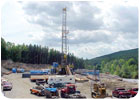
Ever since Colonel Drake drilled the first true oil well in the state of Pennsylvania in 1859, the ability of oil and natural gas to power electric generation plants, transportation, homes and industry has created both immense economic advances and significant controversy. Many times, it has been assumed that the world would quickly run out of oil. In 1939, and again in 1951, the U.S. Department of the Interior warned that all of the Earth’s oil reserves totaled only enough to fuel the world’s nations for about 13 years. In fact, rather than becoming scarcer over time, energy has become much more plentiful. Over much of the history of the energy industry, prices gradually became lower and lower on an inflation-adjusted basis, while a combination of advancing technologies, determined entrepreneurs and alternative sources exponentially expanded the total amount of energy and global reserves available for consumption.
In the same way that the information technology revolution has increased productivity everywhere from the factory floor to the supermarket to the business office, leading-edge technology is shaking up the energy industry. Both onshore and offshore, the use of advanced seismic technologies and horizontal drilling with pinpoint accuracy are drastically improving drilling results.
Offshore, subsea templates that allow both drilling and production of dozens of wells – as much as 15 miles apart – from one underwater structure provide finding and lifting efficiencies undreamed of only a few years ago. Pipeline and transport systems are advancing at the same time. For example, it is now common to deliver oil from a subsea well straight to a pipeline system without ever bringing it to the ocean’s surface.
Geophysicists are using high-powered computer workstations to analyze seismic data in three-dimensional, colorcoded views that show oil- and gas-producing structures never seen before. Drilling success rates are up substantially. An enhanced 4-D system adds the dimension of time to geologists’ seismic view of evolving underground formations. Exploration companies utilizing 3-D and 4-D seismic typically find productive wells more than 70 percent of the time, compared to 40 percent with conventional methods.
Many of these technologies, however, are only refinements of techniques that were discovered many years ago. One very promising technology uses electromagnetic waves (instead of sound) to map features of the earth far below the surface. Instead of mapping density and solidity, as sound does, electromagnetic waves map resistance to electricity. Because oil has a fairly unique electromagnetic signature, maps made with these waves can be incredibly accurate.
Electromagnetic exploration currently is in a period of rapid commercialization. This technology works well in salt water, so it is appearing in deep-sea explorations. However, some firms are performing airborne electromagnetic surveys aboard aircraft. ExxonMobil is one of the first innovators of this technology, calling it Remote Reservoir Resistivity Mapping, or R3M. Another, much smaller company, ElectroMagnetic GeoServices AS, has developed its own version of the technology called SeaBed Logging (SBL) that promises to make this new field very competitive.
ND
This article is provided through the courtesy of Plunkett Research Ltd. It is excerpted from “Plunkett’s Oil & Natural Gas Exploration & Production Trends & Statistics 2007,” which contains a wealth of pertinent information. To receive the complete report, visit www.plunkettresearch.com.
Report Abusive Comment